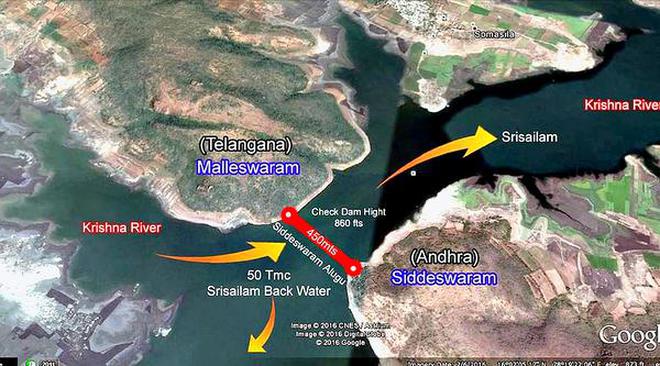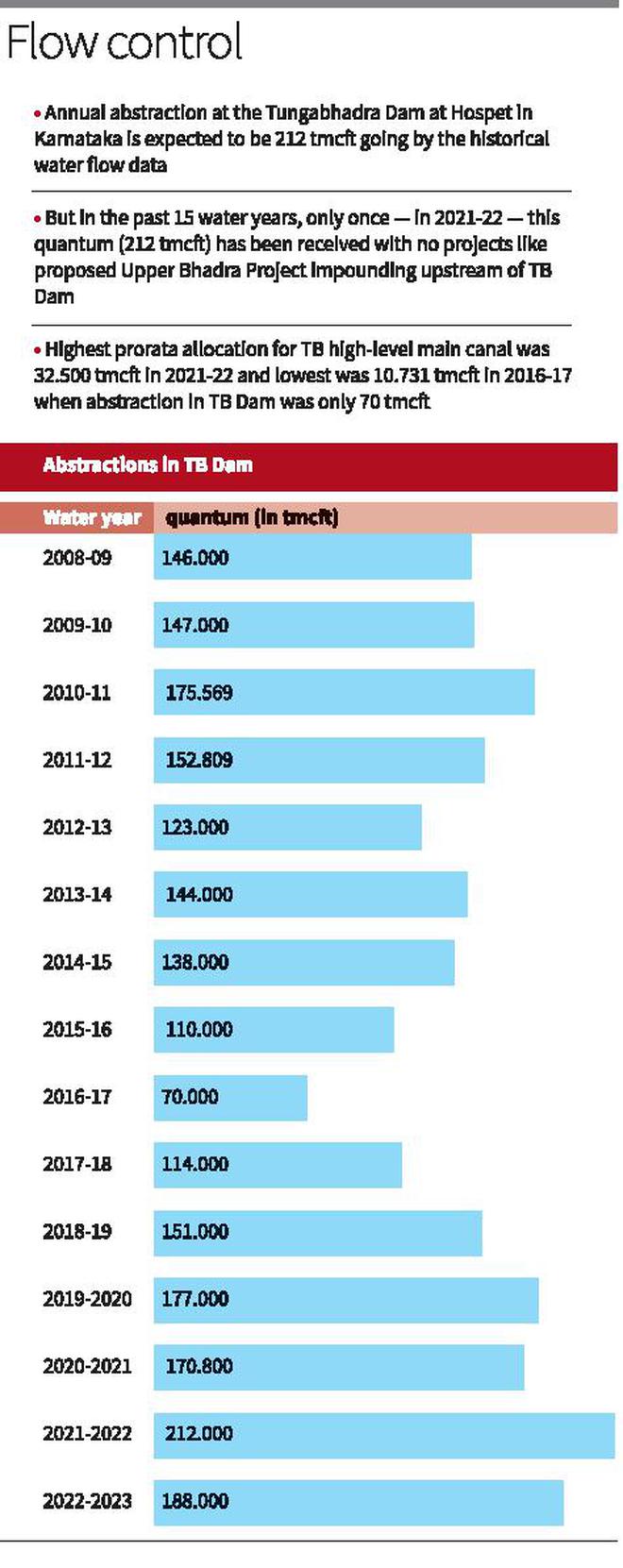For decades, the Rayalaseema region of Andhra Pradesh comprising undivided Kurnool, Anantapur, Kadapa, and Chittoor has grappled with a water scarcity crisis, in terms of both irrigation and drinking water needs. Many areas in this region are either in the rain-shadow or rain-deficit geographical blocks. Unfortunately, successive governments have done little to address this issue and ensure a steady water supply for the region’s 19 lakh acres of agricultural land. Despite an allocated quota of 132 tmcft from the Krishna Basin (out of the total 511 tmcft allocated by the Bachawath Commission for the State, with 299 tmcft for Telangana), the region has been left parched and in dire need of sustainable irrigation solutions.
What is the reality?
As things stand, only 8 lakh acres are irrigated in Rayalaseema region. From the inter-State Tungabhadra Dam, which is on Tungabhadra river, a tributary of Krishna, Andhra Pradesh has an assured water allocation of 32 tmcft , but never has the State been able to draw the full quantum because the Tungabhadra’s high-level main canal (HLMC) that runs over 84.24 km in the Anantapur district has not been modernised. The 48-km-long TB low-level canal (LLC) is supposed to serve an ayacut of 1.51 lakh acres in Kurnool district, but not even half of that is irrigated.
What is the Upper Bhadra project?
The Upper Bhadra Project is a major lift irrigation scheme under implementation in the central region of Karnataka and upstream of the Tungabhadra inter-State dam-cum-reservoir. It envisages lifting of up to 17.40 tmcft of water in the first stage from Tunga River to the existing Bhadra reservoir and later lifting 29.90 tmcft in the second stage from Bhadra reservoir to a tunnel near Ajjampura, in Tungabhadra sub-basin of Krishna basin. The project, which got a ₹5,300 crore allocation in the Union Budget as a national project, is planned to irrigate 2,25,515 hectares through micro irrigation in Chikmagalur, Chitradurga, Tumkur, and Davanagere districts of Karnataka.
What is the threat to Andhra Pradesh?
The main objection of the people of Andhra Pradesh to Upper Bhadra is impounding of allocated water by Karnataka before it reaches the Tungabhadra Dam, which in turn will delay the release of water from the dam to the HLMC and LLC serving Anantapur, YSR Kadapa, and Kurnool districts. Even in a good year, the release of water into Andhra Pradesh happens in the last couple of weeks in July. When water is lifted from the Tunga River, an unfortunate consequence follows — the filling of the TB Dam is delayed. As a result, release of water from the dam is pushed back, causing a significant delay in the sowing season in these districts.
The Bachawath Tribunal had allocated 811 tmcft dependable water to Andhra Pradesh and it later apportioned it in the 512:299 tmcft ratio between Andhra (including parts of Rayalaseema which comprise the Krishna Basin) and Telangana at the time of State bifurcation in 2014. This was done based on the command area developed or utilisation mechanism established by then. There is no mention of water sharing in the Andhra Pradesh Reorganisation Act, 2014, since the KWDT-I Award, which was still in force, had not made any region-wise allocation. The Ministry of Water Resources in 2015 convened a meeting and the governments of Telangana and A.P. had agreed on water-sharing in 34:66 (Telangana:A.P.) ratio as an ad hoc arrangement with the minutes specifying that it has to be reviewed every year.
Andhra Pradesh opposes Upper Bhadra
The Andhra Pradesh government has taken legal recourse by filing an Original Suit (OS) along with an Interim Application (IA) in the Supreme Court on February 9, 2023, to seek an injunction against the construction of the Upper Bhadra Project (UBP) and to challenge the validity of the clearances issued by the Central Water Commission.
The OS was officially registered in the Supreme Court on April 5, 2023 (OS: 4/2023), while the IA was registered with the number 49102/2023, according to the Chief Engineer, Inter State & Water Resources K. Srinivas. The State government had authorised the Chief Engineer to approach the apex court through a letter dated October 23, 2022.
The A.P. government addressed the government of Karnataka regarding the “illegal construction” of Upper Bhadra Project in letters on July 8, 2017, then on July 17, 2018, and again on March 15, 2019 with a request to restrain the construction of any new projects in Krishna Basin, including the UBP.
The A.P. government also wrote to the Ministry of Jal Shakti, through letters on July 30, 2017; July 28, 2019; July 3, 2021; and December 13, 2021, with a request to advise Karnataka not to go ahead with projects permitted by the Krishna Waters Dispute Tribunal-II and to restrain the construction of any new projects in Krishna Basin, including the UBP, which are not permitted by the KWDT-I. A.P. had participated in the 13th meeting of the High-Powered Steering Committee for implementation of National Projects held on December 6, 2021, and raised objections against the UBP.
Responding to the objections vide CWC letter of January 14, 2022, the Ministry of Jal Shakti said that the UBP was approved as per the provisions of KWDT-I. The A.P. government, in turn, wrote to the Ministry and Karnataka on February 9, 2022, requesting them not to go ahead with the UBP without its consent and stated that the hydrological clearance of the UBP may be needed to be re-examined considering the Inter-State issues.

How will Siddheswaram Project help Rayalaseema?
The then Madras Presidency proposed a project to harness Krishna and Penna River waters for irrigating the Rayalaseema, Nellore, and present Tamil Nadu regions. Survey work began in 1947 and plan for a project called Krishna-Pennar Scheme was finalised in 1951. The scheme envisaged the construction of two dams — one on the Krishna at Siddeswaram in Kurnool district, and the other at Someswaram in Nellore district on Penna.
Also read: Rayalaseema forum plans massive movement over Siddheswaram barrage
The idea was to irrigate 21.96 lakh acres in the first stage, and 32.94 lakh acres in the second stage. The scheme also provided for feeding of the Mylavaram reservoir with a discharge of 1,800 cusecs through a proposed Krishna-Penna West Canal that would irrigate 1.5 acres in Kadapa district, but the project was later shelved.

Present context of Siddheswaram
For the first time in 2016, the Rayalaseema Saaguneeti Sadhana Samithi led by Bojja Dasaratharami Reddy revived the issue of constructing a barrage between Siddheswaram in Andhra Pradesh to Malleswaram in Telangana. The foundation stone was laid symbolically on May 31 that year, to impound 70 tmcft of Krishna flood waters and thus stop siltation of the Srisailam Reservoir, which is downstream. The Union government has now proposed a wire-stayed bridge between these two points on the national highway to reduce the distance between Hyderabad and Chennai, but the Rayalaseema people and political activists have been demanding converting this structure into a barrage-cum-bridge project.
The Central Water Resources Department (CWRD) recalled that it had sent a comprehensive report to the State of Andhra Pradesh on January 14, 2022, stating that the Upper Bhadra Project was proposed by the Karnataka government, which is subject to the Bachawat Tribunal allocations. Mr. Reddy said objections raised by A.P. had been cleared at the 14th High Powered Steering Committee meeting held by the CWRD on February 15, 2022.
Mr. Reddy warned that the 20 tmcft water allotted to the Upper Tunga and Upper Bhadra could also pose additional risk to the Siddheswaram project and water allocation of Rayalaseema. “The political class from the Rayalaseema region cutting across the party lines has ignored the issue of Upper Bhadra and remained silent. Their silence continues even with regard to pending projects on River Krishna,” he said.
KRMB office at Kurnool?
The Krishna River Management Board (KRMB) should be set up in Kurnool as its on-ground area of operation lies closer to Kurnool, and the Srisailam reservoir is crucial for the management and distribution of Krishna waters lying in the same district. The KRMB needs to finalise the approvals for projects such as Telugu Ganga, Galeru Nagari, Handri Neeva, Veligonda, Muchumarri, Guru Raghavendra, and Siddapuram lift scheme. For the State government’s part, it needs to expedite the execution so that there is no disparity between the coastal regions and Rayalaseema.
“The political class from the Rayalaseema region cutting across the party lines has ignored the issue of Upper Bhadra and remained silent. Their silence continues even with regard to pending projects on River Krishna”DasaradhaRami Reddy







